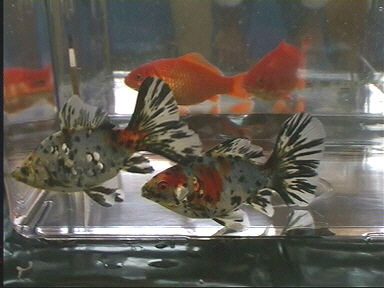



I find the best way to do this is by putting them in salt water for a few days (again a weak solution will do - not full strength sea water!); the heavy mucus will come off and the fish will look nice and clean.
Once the mucus has been removed, you can then clear the body and gill of any associated 'flukes' and other parasites by using a bath made up of one teaspoonful of 'Dettol' to three gallons of water.
Put the fish in the bath and leave until they start to get agitated; take them out and put them back into some clean water for a few minutes to recover they'll probably be allover the place for quite some time but don't worry about them, they'll soon be O.K.
You can now put them into our cleaned tank (they still might look sick, and still take a couple of hours further to fully recover, but they will come right -
I haven't lost one yet!)
To condition the fish for breeding, I increase the water temperature to about 50°F for a week or so, and start feeding lightly; increase the temperature by another 5 ° and feed a little heavier. Repeat this process once more, to get the temperature up to 65°F which I consider to be the ideal spawning temperature.
I do this process over a period of about 4-5 weeks; any faster and the males don't seem to have much milt or if they do, it's weak and watery - I prefer to see it nice and thick and milky. You hear a lot of people say they have infertile spawnings, I feel the cause is because their male's milt is so weak.
The female fish should have no trouble in forming their eggs if you fed them well during the previous year; to make the fish more comfortable put plenty of plants, or mops, in the tank.
Personally, I prefer to hand-spawn my fish; this leaves nothing to chance, as I can use the fishes I prefer (for their inherent characteristics - size, colour, finnage or whatever) without Mother Nature providing me with fry I would rather not have. For a spawning receptacle, I usually make use of a washing up bowl or ice-cream container filled with water from the fishes' tank; the males and females I keep in separate buckets until I'm ready for them.
I use the males first, which may seem a little odd to you, and gently milk their milt allover the surface of the water in the container; I then take the female and, gently stroking (never squeezing) at the vent expel the eggs so that they drop down through the milt into the water during which time they should (hopefully!) become fertilised. I think this is a more productive way than expecting the milt to fall down through the water to reach the eggs on the bottom of the container - I've always had a much better fertility rate this way.
I leave the eggs for a couple of minutes in the milt/water for a couple of minutes before I rinse them off in clean water.
I float the containers in the tank and turn up the temperature to 70°F.
Within 3-4 days the eggs should start to hatch out. After a further 24 hours, the fry will have used up their yolksacs and will need some form of fine first food. Liquify No. 1 (for Egglayers) is given for the next 2-3 days after which they get started on Brine Shrimp.
All this time you must be careful not to overdo the feeding which will pollute the water. If you follow this early procedure, the fry will get off to a good start and grow quite quickly. After this it is up to you to continue the good work -then you've got the problems of what to do with the large number of, hopefully, healthy, well-fed young fishes!
Of course, there will be someone out there who does it all differently and has just as good results, but that's what it's all about isn't it?
We can all learn from each other, but once you find your own recipe for success then my advice is stick to it no matter what anyone else says or does!
Last updated March 2005